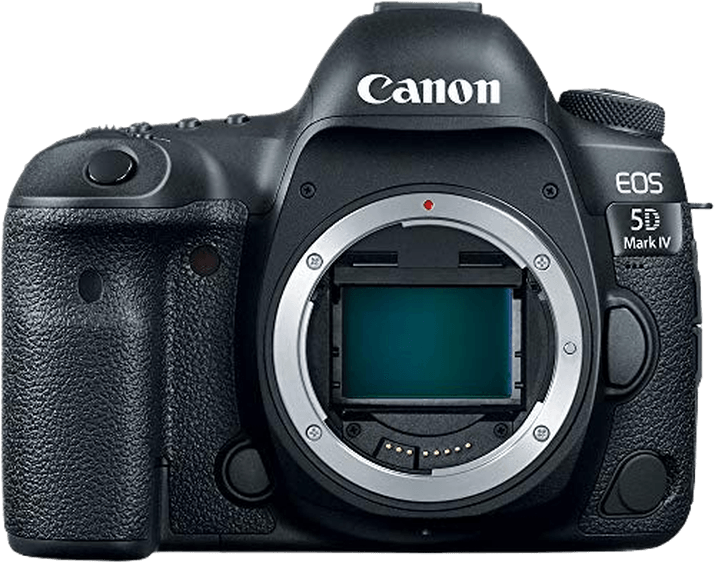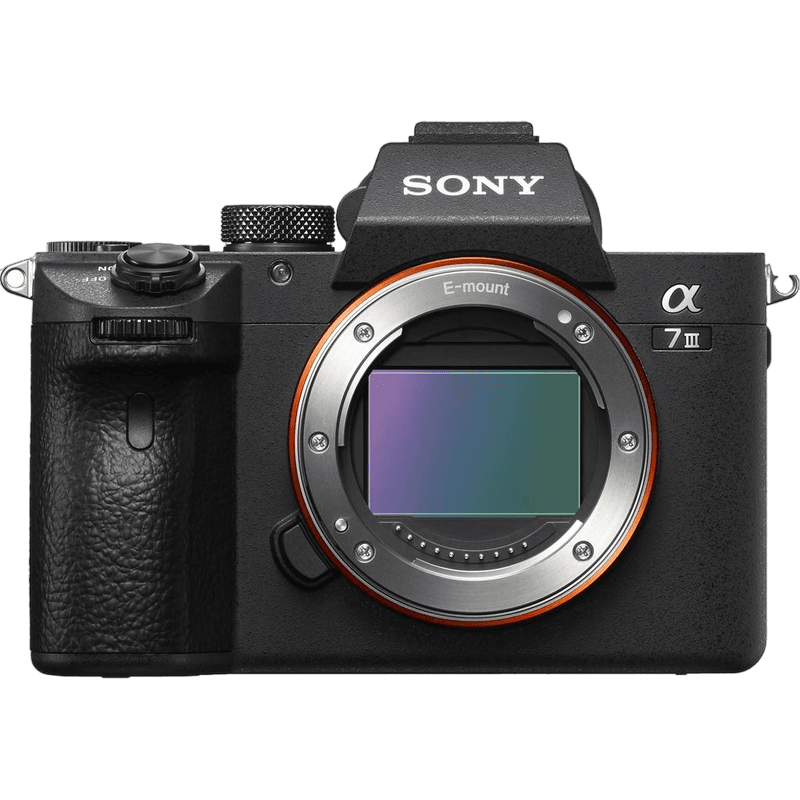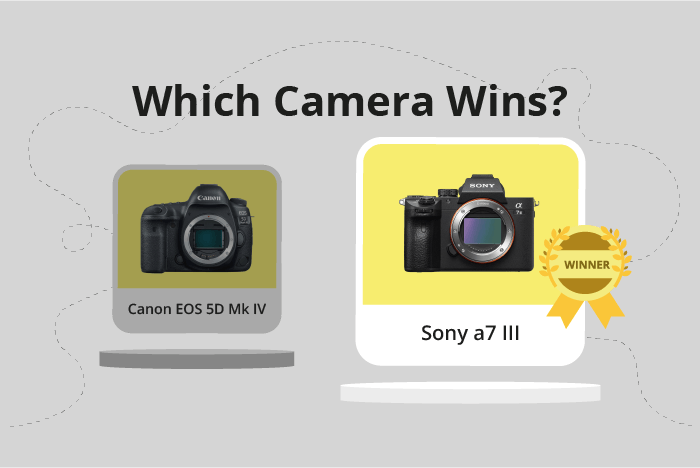Canon EOS 5D Mark IV vs Sony a7 III Comparison
Canon EOS 5D Mark IV

Sony a7 III

The Sony a7 III emerges as the winner with a score of 81, while the Canon EOS 5D Mark IV trails behind with a 75/100. Both cameras were released in 2016 and 2018, respectively, with the 5D Mark IV being a DSLR and the a7 III a mirrorless camera. They share similarities in their announcement dates, release years, and camera sizes.
The Sony a7 III excels with a lower launch price of $2000 and a lighter weight of 650g. On the other hand, the Canon EOS 5D Mark IV boasts a larger camera size at 151 x 116 x 76mm and a heavier weight of 890g. Although the 5D Mark IV is bigger and heavier, it might offer a better grip and sturdiness for some photographers.
Taking these points into consideration, the Sony a7 III stands out as a more affordable and lightweight option, while the Canon EOS 5D Mark IV caters to those who prefer a larger and more robust camera.
Canon EOS 5D Mark IV vs Sony a7 III Overview and Optics
The Sony a7 III emerges as the winner in the optics comparison with a score of 81/100, outperforming the Canon EOS 5D Mark IV’s score of 76/100. Both cameras share some common features: they are equipped with CMOS sensors, full-frame sensor sizes, and similar processors (Bionz X for Sony and Digic 6+ for Canon).
The Sony a7 III outshines the Canon 5D Mark IV in several aspects. It has a higher DXOMARK sensor score of 96 compared to Canon’s 91, indicating better overall image quality. Additionally, the Sony a7 III offers a faster shooting speed of 10 frames per second, compared to Canon’s 7, allowing for better action and sports photography. A crucial advantage of the Sony a7 III is its built-in image stabilization, which the Canon 5D Mark IV lacks. This feature helps reduce camera shake, resulting in sharper images, especially in low light conditions or with longer lenses.
On the other hand, the Canon EOS 5D Mark IV has a higher megapixel count of 30.4 compared to Sony’s 24.2, which provides more detail and better cropping flexibility in images. Moreover, the Canon 5D Mark IV uses the Canon EF lens mount, which has a vast selection of lenses available.
In terms of optics, the Sony a7 III is the superior choice due to its higher sensor score, faster shooting speed, and built-in image stabilization. However, the Canon EOS 5D Mark IV also has its merits with a higher megapixel count and a wide range of compatible lenses. Ultimately, the choice between the two cameras depends on the user’s priorities and preferences in photography.
Canon EOS 5D Mark IV vs Sony a7 III Video Performance
The Canon EOS 5D Mark IV emerges as the winner in video capabilities with a score of 91/100, while the Sony a7 III scores 70. Both cameras share some common specifications, such as the ability to record 4K video. However, there are notable differences that highlight the strengths of each camera.
The Canon EOS 5D Mark IV boasts a higher maximum video resolution, with dimensions of 4096 x 2160, compared to the Sony a7 III, which has a maximum video resolution of 3840 x 2160. Additionally, the Canon 5D Mark IV has a superior maximum video frame rate of 120fps, significantly higher than the Sony a7 III’s 30fps. This higher frame rate allows for smoother slow-motion playback, providing more creative options for videographers.
On the other hand, the Sony a7 III still delivers quality 4K video, albeit at a lower resolution and frame rate. While it lacks built-in time-lapse functionality, this can be overcome with external accessories or software. Despite its lower score, the Sony a7 III remains a capable camera for video recording.
Considering these points, the Canon EOS 5D Mark IV excels in video capabilities, offering higher resolution, better frame rates, and built-in time-lapse functionality. The Sony a7 III, while not as powerful, still provides quality 4K video recording. Videographers may choose the Canon 5D Mark IV for its superior video features, while those who prioritize other factors may still find the Sony a7 III suitable for their needs.
Canon EOS 5D Mark IV vs Sony a7 III Features and Benefits
The Sony a7 III emerges as the winner with a feature score of 81/100 compared to the Canon EOS 5D Mark IV’s 74/100. Both cameras share some common specifications, such as touchscreen functionality and Wi-Fi connectivity. However, the Sony a7 III outperforms the Canon EOS 5D Mark IV in several aspects.
The Sony a7 III has a flip screen, providing more flexibility for shooting at different angles. It also offers Bluetooth connectivity, which the Canon EOS 5D Mark IV lacks. Despite having a slightly smaller screen size (3 inches) compared to the Canon EOS 5D Mark IV (3.2 inches), the Sony a7 III’s superior features contribute to its higher score.
On the other hand, the Canon EOS 5D Mark IV has a higher screen resolution (1,620,000 dots) than the Sony a7 III (921,600 dots), which results in a clearer and sharper display. Additionally, the Canon EOS 5D Mark IV includes GPS functionality, allowing for geotagging of photos, a feature not available in the Sony a7 III.
In comparing these two cameras, the Sony a7 III’s flip screen and Bluetooth connectivity give it an edge over the Canon EOS 5D Mark IV. However, the Canon EOS 5D Mark IV’s higher screen resolution and GPS functionality may appeal to photographers who prioritize image clarity and location information. Ultimately, the choice between these cameras depends on the specific needs and preferences of the photographer.
Canon EOS 5D Mark IV vs Sony a7 III Storage and Battery
Both Canon EOS 5D Mark IV edges and the Sony a7 III have two memory card slots. The 5D Mark IV accepts SD/SDHC/SDXC (UHS-I compatible) and Compact Flash cards, while the a7 III takes SD/SDHC/SDXC and Memory Stick Duo/Pro Duo/Pro-HG Duo cards. Only the a7 III supports USB charging
The 5D Mark IV has a longer battery life of 900 shots, using the LP-E6N battery type. In contrast, the a7 III offers 750 shots with its NP-FZ100 battery. This difference gives the Canon camera an advantage in extended shooting sessions.
However, the Sony a7 III provides more versatility in memory card options, accommodating Memory Stick Duo cards in addition to SD/SDHC/SDXC cards. This could be beneficial for users with existing Memory Stick Duo cards.
Considering these factors, the Canon EOS 5D Mark IV has a slight edge in storage and battery performance due to its longer battery life. The Sony a7 III offers more memory card compatibility but falls short in battery life compared to its competitor.
Alternatives to the Canon EOS 5D Mark IV and Sony a7 III
Are you still undecided about which camera is right for you? Have a look at these popular comparisons that feature the Canon EOS 5D Mark IV or the Sony a7 III:

